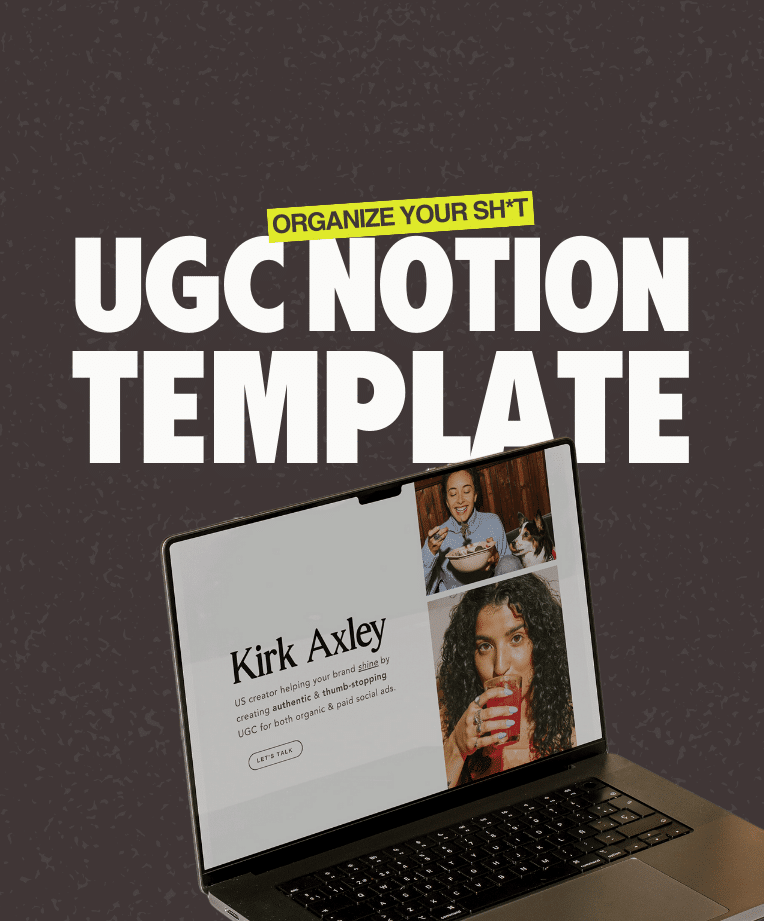As a UGC creator, you play a pivotal role in D2C landscape, bridging the gap between brands and consumers with creative concepts. But nailing content for a brand relies on your ability to interpret their brief and deliver not just what they want, but what they need.
This means speaking their language, and we don’t just mean ROAS. Pop quiz: can you define CPC, CAC or CLV? If so, can you use them to improve your deliverables…
If not, then it’s time to study up. Today we’re delving into the KPI’s that media buyers prioritize when evaluating ad performance, and pivotal questions you should be asking as a UGC creator.
Whether you’re a seasoned UGC creator looking to refine your skills or a newcomer eager to make your mark, this guide will help you understand the metrics that truly matter in the advertising world and how they influence campaign results.
The KPI’s You Need To Know As a UGC Creator
Being able to start, take part and truly understand conversations around KPI’s with your clients will set you apart from other UGC creators. There’s no two ways around it, everyone and their mom is a UGC creator nowadays (or at least it feels that way). To hold your own in the industry, you need to be able to deliver results — to do that consistently you need to understand the data.
By doing so, you take yourself from being just a content creator, to a content creator that’s also a strategist who deserves the big bucks. Ok. So how?
We all know and use ROAS— this is the single easiest way to be able to justify your rates to potential clients. But it’s also not the only metric that marketing professionals on the brand side will be tracking and listening to, so it’s not the only one you should know.
The KPI’s can vary depending on the goals of the campaign. But some of the key metrics you want to know and understand are:
| Metric | Definition | Formula | Example |
|---|---|---|---|
| Customer Acquisition Cost (CAC) | The cost incurred to acquire a new customer. | CAC = Total Cost of Acquisition/Number of Customers Acquired | If you spend $1000 on a campaign and acquire 50 customers, the CAC is $20. |
| Return on Ad Spend (ROAS) | Measures the revenue generated per dollar spent on advertising. | ROAS = Revenue/Ad Spend | If you spend $100 on an ad and generate $500 in revenue, the ROAS is 5. |
| Conversion Rate | The percentage of completed goals (conversion) to the total number of visitors. | Conversion Rate = (Conversions/Total Vistors) x 100 | If 200 people visit your landing page and 20 make a purchase, the conversion rate is 10%. |
| Return on Investment (ROI) | Measures the profitability of a campaign. | ROI = (Net Profit/Cost of Campaign) x 100 | If you spend $1000 on a campaign and make a net profit of $20000, the ROI is 200%. |
| Click-Through Rate (CTR) | The average cost incurred for each click on your ad. | CTR = Total Ad Spend/Total Clicks | If your ad has 1000 impressions and receives 50 clicks, the CTR would be 5%. |
| Cost Per Click (CPC) | The average cost incurred for each click on your ad. | CPC = Total Ad Spend/Total Clicks | If you spend $100 on an ad and get 50 clicks, the CPC is $2. |
| Cost Per Conversion | The average cost incurred for each conversion. | Cost Per Conversion = Total As Spend/Total Conversions | If you spend $100 and get 10 conversions the cost per conversion is $10. |
| Customer Lifetime Value (CLV) | The total revenue a company expects to earn from a customer throughout their entire relationship. | CLV = Average Purchase Value x Purchase Frequency x Customer Lifespan |
Ultimately, the most important metrics will depend on the campaign’s objectives. If the goal is to increase brand awareness, metrics like reach and engagement might be prioritized. If it’s about driving sales, conversion-related metrics will be crucial.
The most important thing really is to establish clear KPIs with your client before you start working on the campaign. This ensures that everyone is on the same page regarding what success looks like and which metrics to prioritize — ask the questions early, and avoid confusion later down the line.
Which brings us to the questions you should be asking. As a content creator, you’re parterining with these brands to deliver a service. You should be getting as much information as possible to allow you to do this in the most effective way.
Do not be a silent partner.
Questions to Ask Before Partnership
What are the campaign objectives?
Reason: Knowing the brand’s objectives will help you understand what success looks like for this partnership.
Explained: If the brand’s objective is to increase conversions, you’ll want to know how they measure this (e.g. # of purchases, ATC, or other desired actions).
What are the key performance indicators (KPIs) you’re using to measure the success of the content?
Reason: Understanding the KPIs will help you align your content with the brand’s objectives.
Explained: If the brand is focusing on engagement, you’ll know to create content that encourages likes, shares and comments.
What is the best-performing video on your ad account?
Reason: Request the KPI metrics too! This will give you an idea of what has worked well for the brand in the past, helping you understand what has been considered successful.
Explained: If the brand’s top video had strong conversion rates with user testimonials, you can use this as a benchmark for your own content’s effectiveness

Questions to Ask After A UGC Partnership..
What was the ad spend range on the content provided?
Reason: Knowing the ad spend helps you understand the scalability of your content and how much was invested to achieve the reported ROAS.
Explained: If the ROAS is high but the ad spend is low, you’ll want to discuss the potential for scaling up the campaign.
Can you share the ROAS (Return on Ad Spend) for campaigns featuring my content?
Reason: This will help you gauge the effectiveness of your content.
Explained: If the ROAS is high, this is a strong indicator that your content is driving profitable actions.
What is the click-through rate (CTR) for the content provided?
Reason: This will help you gauge how effective your content has been at driving users to the website.
Explained: If the CTR is low, you’ll want to know how this compares to the brand’s average CTR for similar campaigns.
As a UGC creator, you are more than just a content producer; you are a strategic partner in the dynamic landscape of digital marketing. Your ability to speak the brand’s language, is a critical asset that sets you apart in an increasingly competitive field. If you’re not living up to your potential as a UGC creator, be better. That starts with getting to grips with the science behind this creative biz. Good luck.










